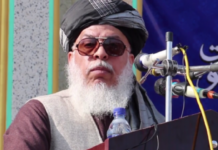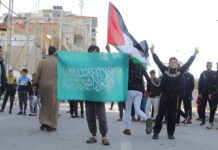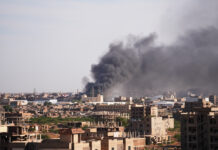Amjad Mohamed-Saleem argues that virulent Sinhalese Buddhist nationalism, borne out of the country’s brutal civil war, poses a real danger to Muslims and other minorities in Sri Lanka.
On 18 May 2009, the prolonged separatist conflict in Sri Lanka between the Liberation Tigers of Tamil Eelam (LTTE) and the Government of Sri Lanka came to an end with the death of the LTTE Leader Vellupillai Prabhakaran.
The demise of the LTTE, one of most ruthless terrorist groups in the world, signalled the conclusion of one of the most turbulent periods of Sri Lanka’s history. The LTTE had been a powerful military force, and had controlled territory as well as running a civil administration in the north and east of Sri Lanka for many years.
The Muslims in particular had suffered at the hands of the LTTE in the late 80s and early 90s with the mosque massacres in the east of the country and being expelled from the north. Thus its end symbolized an opening of a window of opportunity, albeit with some uncertainty for the country’s future, in terms of trust-building and reconciliation between increasingly suspicious and polarized communities.
Fear of the “other”
The 28-year-old conflict extenuated already fragile cracks between the different ethnic groups, along faith lines, such that identity was strengthened not only by an insecurity of religious affiliation, but by a religious affiliation borne from a sense of the “other” – someone of a different ethnicity and someone of a different religion.
Like many post-colonial societies, Sri Lanka drew on pre-colonial culture, including religion, to form a national identity after gaining independence. These post-colonial identities subsequently contributed to the conflict and have been abused and manipulated by the political elites to justify certain actions.
Subscribe to our newsletter and stay updated on the latest news and updates from around the Muslim world!
This insecurity of identity has been felt on all sides, but the Sinhala Buddhist, who form the majority of the population, exhibit the most extreme of strains. In particular the ideological strand of Theravada Buddhism in Sri Lanka has undergone a massive change and reinterpretation of its doctrines not only as a result of the conflict, but also by the political and social climate which has resulted in the steady growth of political activism on the part of a new generation of Buddhist monks.
This means that the Sinhala Buddhist has become more militant, violent and ultimately intolerant towards other ethnicities and religions, largely led by the clergy. The past three and a half years has seen a rise of violence against religious sites and members of religious communities, with a number of incidents including mob attacks on places of worship; robberies and vandalism; the killing of clergy; protests against communities and the proliferation of hate speech on social media, the internet and via the audio-visual media.
Muslim community targeted
In particular once again it seems to be the Muslim community that is the main target from both a commercial, social and religious perspective with some high profile cases such as the attack on a mosque in Dambulla in Sri Lanka in 2012. In addition there have been many more incidents that have received little or no attention, either locally or internationally.
Of the accounted reports, there are 65 cases of attacks on places of religious worship with all the minority religious communities bearing the brunt of the violence, the majority being from the Christian community (mostly against the non-traditional churches accused of forced conversion); Buddhist temples from the non Theravada sect; Hindu places of worship and the Muslim community.
At the front of this coordinated hate campaign is an extreme Sinhalese Buddhist organisation called Bodhu Bala Sena (BBS), enjoying tacit support from the government. This rising anti-Muslim rhetoric over the last few years have involved public meetings, the distribution of pamphlets and articles in mainstream Sinhala and English papers which have borrowed rhetoric being used globally to demonise and stereotype Muslims (especially by Islamophobes in the West). There are also rumours that on a recent visit to the USA, the BBS were scheduled to have met Pamela Geller as well.
It is an irony that this anti-Muslim movement is oblivious to the lived experience of the Sri Lankan Muslim society which has over 1000 years of coexistence in the country and contributing at all levels of the State. However it is clear that the movement is aimed at hitting the Muslim community in areas that aim to decrease their visibility and thereby the “threat” to Sinhala identity and ultimately Sri Lanka (in the eyes of the protagonists).
“Sinhala only”
By declaring Sri Lanka as a “Sinhala only” country, those perpetrating this mindless rhetoric of Sinhala supremacism presuppose the acceptance of Sri Lanka as a land sacred to Buddhism with Sinhala Buddhists as its chosen people. According to this vision, minorities, including Sinhala Christians are not co-owners or even guests (because guests have to be given certain privileges and rights) but they are second-class serfs (untouchables) who should thank the benevolent majority for being given the chance to live there.
In so doing, these organisations have completely rewritten the rich history of a country whose mosaic is made up of different ethnicities, faith and culture. They have chosen to rewrite a history of the accumulation of unfinished business, the piling-up of debts and the stacking up of fortunes and misfortunes.
Whilst it is true that Sri Lanka is the only place in which there are Sinhalese and where the Sinhalese language is spoken, this doesn’t equate to ownership of the island solely by one race or another nor does it speak of the rich inter-mingling of all races and faiths that influence much of Sri Lankan culture, food, art and music today. It also does a huge disservice to the Buddhist way of life which is about peace, tranquillity and tolerance of others. Declaring Sri Lanka Buddhist doesn’t preclude it from having minorities of other faiths and ethnicities co-existing with equal rights.
Isolationism
Of course, questions need to be also asked of the Muslim community in terms of their isolationist attitudes which have led to large misperceptions about them and their practices. Despite a history of coexistence, the past 30 years have seen more communities living in parallel to each other. The BBS movement have brought to the fore basic ignorance about the rituals and practice of Muslims.
In addition, the inability of the community to define a home grown organic identity and instead adopting more of an identity similar to that found in the Middle East caused a lot more questions. One such question that the Muslim community will have to discuss and deliberate on is the whole issue of a national identity versus religious obligations. But their commitment to the process of reconciliation of Sri Lanka should not be questioned at the expense of their identity.
The Muslim issue in particular adds an additional significant challenge to Sri Lanka’s external relationships especially as in the recent and distant past; it has been the Muslim world which has been supportive of the country in the international sphere.
In addition, with the significant amount of income coming from Sri Lankans employed in the Middle East, the destination for Sri Lankan exports and Middle East tourism, the challenges faced by the Muslim community will only serve to deteriorate Sri Lanka’s international standing even further.
Thus for Sri Lanka to move forward it will need to have some serious deliberations on the path it chooses to take. The Muslim community themselves have a role to play in this, and will have to exorcise some internal demons as well.




















